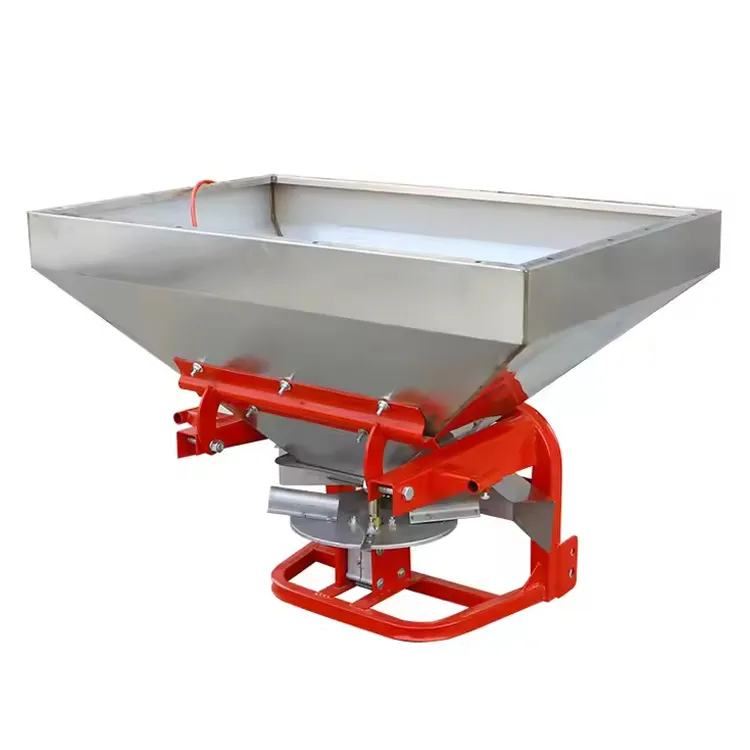How Does a Fertilizer Spreader Work?
2024-11-27
A fertilizer spreader is a gardening or agricultural tool designed to distribute fertilizers evenly across a lawn, garden, or field. By ensuring that nutrients are spread consistently, it helps promote healthy plant growth and improves soil fertility. Fertilizer spreaders come in various types, but the basic principle of their operation remains the same. In this blog, we’ll explore how a fertilizer spreader works, the different types available, and tips for using them effectively.
1. Understanding the Mechanism of a Fertilizer Spreader
A fertilizer spreader works by distributing granular or liquid fertilizer across a targeted area. The fertilizer is placed in a hopper or container, and the spreader uses mechanical action to release and spread the material. The two key functions of a fertilizer spreader are:
1. Dispensing the Fertilizer: The spreader releases the fertilizer through a series of openings or a rotating disc.
2. Spreading the Fertilizer: Once released, the fertilizer is spread in a uniform pattern, either by gravity or centrifugal force, depending on the design of the spreader.
2. Types of Fertilizer Spreaders
There are two primary types of fertilizer spreaders: broadcast spreaders and drop spreaders. Each type has its unique design and benefits.
a. Broadcast (Rotary) Spreader
- How It Works: A broadcast spreader features a rotating disc or a set of spinning blades that fling the fertilizer in a broad pattern as the operator walks or drives behind it. The fertilizer is cast in a wide arc, typically covering a larger area.
- Best For: Large lawns, gardens, or fields. It’s efficient for covering a broad area quickly.
- Advantages: Fast and efficient, covers a wide swath, and works well for applying granular fertilizers, lime, or seeds.
- Disadvantages: It can be difficult to control the distribution pattern precisely, which may result in uneven coverage, especially near boundaries.
b. Drop Spreader
- How It Works: A drop spreader uses a set of smaller openings located at the base of the hopper. The fertilizer falls directly down into a narrow strip below the spreader, ensuring it’s applied in a linear, straight line.
- Best For: Smaller areas where precise application is necessary, such as lawns, flower beds, or vegetable gardens.
- Advantages: Offers more accurate control over fertilizer distribution, making it ideal for edging, avoiding non-grassy areas, or fertilizing close to plants.
- Disadvantages: Slower and less efficient for covering large areas. Requires more attention to ensure even coverage.
c. Handheld or Push Fertilizer Spreaders
- How They Work: These are smaller spreaders, typically designed for home use. They operate in a similar fashion to broadcast or drop spreaders but are manually pushed or carried. They are often designed for smaller lawns or specific garden areas.
- Best For: Small to medium-sized lawns or specific areas like flower beds.
- Advantages: Portable, easy to use, and relatively inexpensive.
- Disadvantages: Limited capacity and coverage area.
d. Tow-Behind Spreader
- How It Works: This type of spreader is typically towed behind a lawn tractor, ATV, or garden tractor. It uses the tractor’s power to drive the spreader and may feature a large hopper and rotary disc to broadcast fertilizer.
- Best For: Large residential properties, farms, or commercial applications where a bigger spreader is necessary.
- Advantages: Saves time and effort, ideal for larger properties.
- Disadvantages: Expensive, requires a towing vehicle, and is less flexible in tight spaces.

3. Key Features of a Fertilizer Spreader
When choosing a fertilizer spreader, several features will affect its performance and suitability for your needs:
- Hopper Capacity: The size of the hopper determines how much fertilizer you can load at once. Larger hoppers mean fewer refills but can be heavy and cumbersome.
- Control Settings: Many modern spreaders offer adjustable flow control to regulate the amount of fertilizer dispensed. This allows for more precise application and prevents waste.
- Wheel Design: Wheels that are durable and have good traction help ensure smooth operation across uneven terrain. Some spreaders have pneumatic tires for better grip.
- Spread Pattern Adjustment: Some spreaders allow you to adjust the width of the spread pattern, giving you more control over coverage and preventing excess fertilizer from being spread in unintended areas.
- Material Durability: Spreader frames made from corrosion-resistant materials (e.g., stainless steel or heavy-duty plastic) are more durable, especially if you're working with salt or other harsh fertilizers.
4. How to Use a Fertilizer Spreader Effectively
To get the best results and ensure even distribution of fertilizer, follow these steps:
1. Check the Spreader Settings: Before starting, adjust the flow control according to the type of fertilizer you’re using. Refer to the fertilizer package for the recommended setting.
2. Calibrate the Spreader: Calibration ensures you are applying the correct amount of fertilizer. Measure the area you plan to cover and perform a test run to make sure the fertilizer is being applied evenly.
3. Overlap Passes: When using a broadcast spreader, slightly overlap your passes to ensure complete coverage and prevent gaps.
4. Walk or Drive at a Steady Pace: For consistent application, walk or drive at a steady pace. Avoid rushing, as this can lead to uneven spreading.
5. Apply in Multiple Directions: For better coverage, apply fertilizer in two perpendicular directions (e.g., once north-south, then east-west) to ensure uniform distribution.
6. Clean the Spreader After Use: Always clean the spreader after use, especially if it was used with fertilizer or weed control chemicals, to prevent clogging or corrosion.
5. Tips for Best Results
- Fertilizer Timing: Apply fertilizer during the growing season when your plants need it the most. Spring and fall are typically the best times for lawn fertilizers.
- Consider Weather Conditions: Avoid applying fertilizer during windy or rainy weather. Wind can cause uneven distribution, and rain can wash away the fertilizer.
- Choose the Right Fertilizer: Choose a fertilizer type (granular, slow-release, organic, etc.) that matches your plants' specific nutritional needs.
Conclusion
A fertilizer spreader is a practical tool for efficiently applying fertilizer to large areas, whether it’s for a lush lawn, garden, or field. By understanding the different types of spreaders, key features to look for, and how to use them correctly, you can optimize the growth and health of your plants. Whether you're a homeowner looking to improve your lawn or a farmer managing a large crop, the right fertilizer spreader can make a big difference in your efforts.
Do you use a fertilizer spreader for your lawn or garden? Share your tips and experiences in the comments below!


